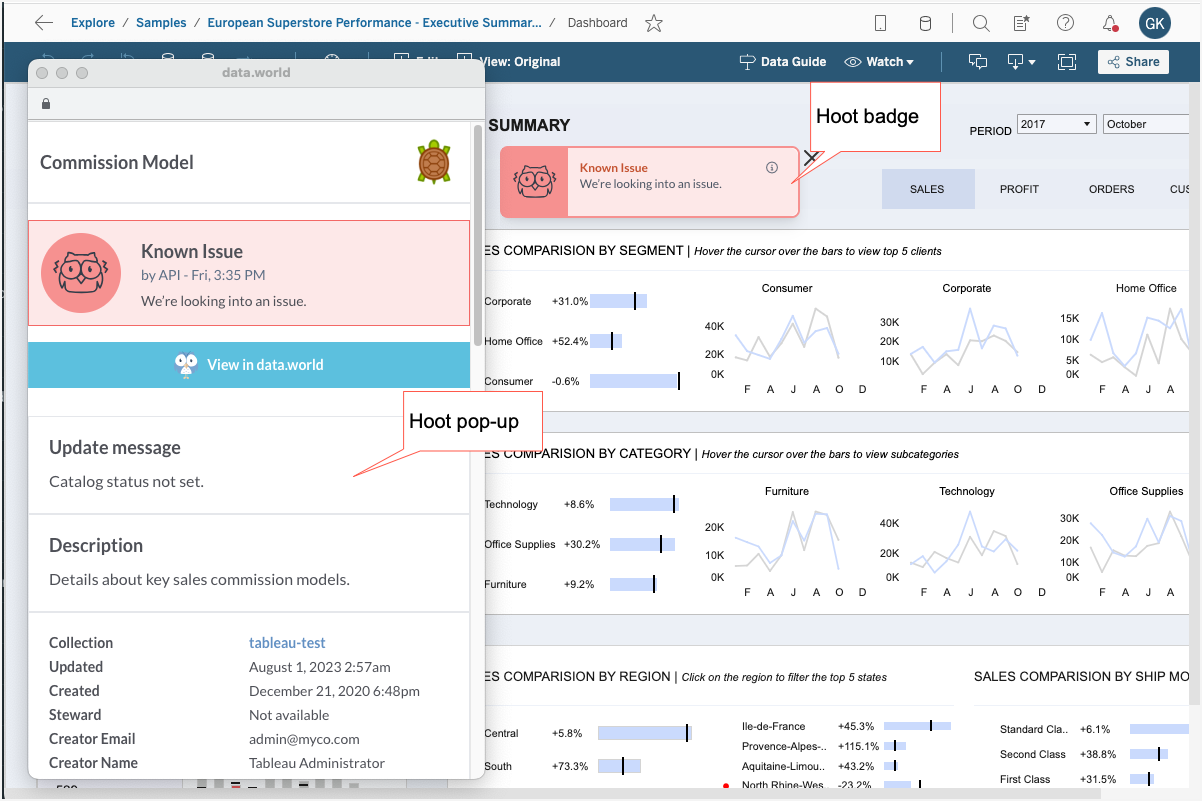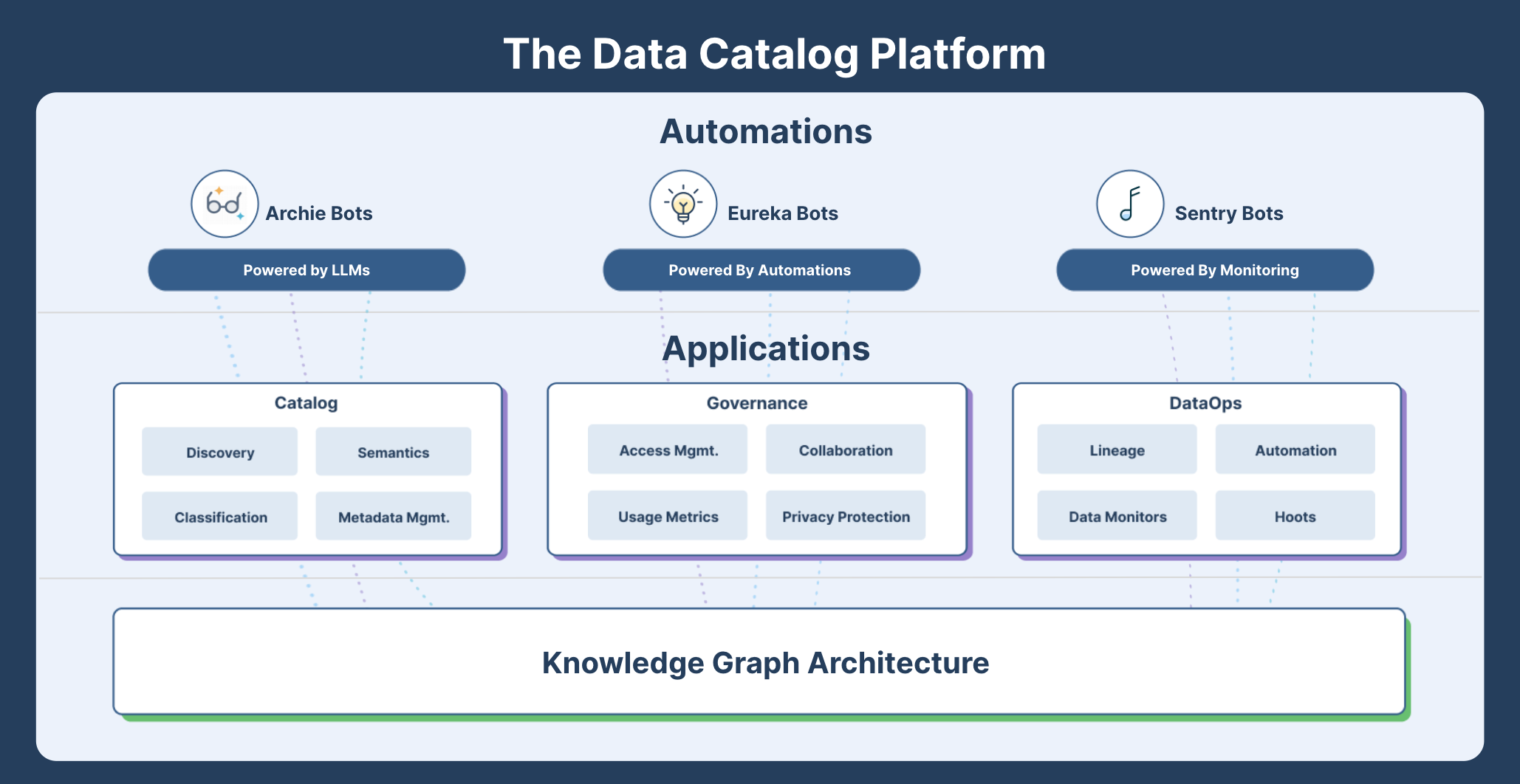About Hoots and Sentries
Warning
Old hoot admin portal is deprecated!
The old Hoot admin portal is no longer supported but remains accessible from the product (under Settings > Hoots) until January 16, 2026, to allow time for you to setup the new Hoots and complete the migration.
If you prefer to disable access to the old portal before that date, please contact data.world support for assistance.
To increase the trust and confidence of your data consumers, add a trust badge on the dashboards, called a Hoot. Hoots let you curate the parts of the catalog that are important to the data consumers and surface them easily on the dashboards. These provide real-time information to users on the assets, without having to consult the catalog or constantly monitor channels like emails and slack messages for current status.
The Hoot badges are designed to be very simple, and provide 3 types of indicators to the users:
Blue - Neutral status: No status is set for the hoot.

Happy - Green status: The data is healthy and has no known issues.

Warn -Yellow status: Is a warning that there might be issues and someone is looking into them and use the data with caution.

Sick - Red status: There are serious issues with the data and it needs attention.

These badges are available to all users even if they do not have access to the complete catalog. Users who do have catalog access can expand to a more detailed view to automatically obtain comprehensive resource information (like related resources, etc.) from the catalog. Any changes made to the resource in the catalog are automatically reflected on the Hoot page. For example, if you add or remove business glossary terms from a resource, it is immediately reflected on the Hoot.

Setting up a hoot is as simple as going to a resource in the catalog and clicking the Configure hoot button for it. For each Hoot, a corresponding Sentry gets created in the Hoot Admin space. To further enhance the experience of the Hoot, you can create Sentries manually and connect them with the Hoot. You would want to do this in scenarios such as 1. you want to have the Hoot get more frequently updated than the catalog status update intervals. 2. You have not cataloged all the parts of the data pipeline.
Important
Only users with the Organization Administrator privilege can manage hoots and sentries.
The system provides an easy way to integrate with dbt cloud jobs. For example, let us say you have streaming data from your online sales that need to monitored more frequently because it is being used in some high value dashboards to make crucial business decisions through the day. For that reason you may have set a dbt job to run hourly. Sentries provide a seamlessly integration with dbt cloud which allows you to hook into your jobs. We automatically map the outcomes of those jobs (OK, warn, error) to the states of the Hoots (Happy, Sad, and Sick).
The Sentries allow the data engineers to be proactive and quickly let stakeholders know about the state of things through automated real-time monitors. This way, data consumers stay aware of any issues proactively while data engineers can focus on investigating and addressing the root cause.

Important
For more insights from our product experts, watch "Is my data OK?" Gain visibility into Schrödinger's data box through automated data health updates
Why would you use Sentries and Hoots?
Hoots provide trust in the governance of the data product. If a stakeholder sees the Hoot they know the product is being monitored by the data team and they can quickly get a color-coded signal regarding the health of the data product. Red = sick, Green = happy, Yellow = sad. These correspond with the Negative, Positive, and Neutral asset status available for catalog resources.
Sentries provide a way for the DataOps team to chain together real-time monitoring and messaging from various sources - so even more than the catalog status.
Hoot Usage gives data teams a quick pulse on their ROI and which products are getting utilized.
Key user personas for Hoots and Sentries
Business users: As data and analytics are being pushed to more and more rank-and-file employees, people with little to no data literacy are now expected to make sense of this information. The hoots provide the simplest, lowest cognitive load way for these users to know if they can trust a report. And if they have a question, they can see the Hoot as the icon for help and trust in data.
Data teams: Data teams have to be reactive as business needs for data change constantly. Business priorities and initiatives are fluid. Data teams also have to contend with the rise of "shadow BI" - people promoting alternate data to support their personal theories or agendas. The hoots are data teams' stamp of approval on a report, signaling to users that the information could be trusted.
What are the key use cases?
As a business user or stakeholder, you need to quickly understand if the data product is trustworthy and governed. I want to know quickly if there are any known issues, what the terms mean, and where I can find more information. Hoots help you trust and understand.
As a data team member, you need to quickly communicate known issues in your data pipeline that affect the status or health of a data product. You also don’t want to have to answer the same questions over and over and want to spend your time doing more proactive work, rather than reacting to questions that the catalog could answer for the user. Sentries help you communicate trust and encourage more self-service by utilizing the catalog.
As a data team or data product manager, you need to understand which reports are the most utilized so that you can monitor them and keep them healthy. You also need to understand which are the least utilized so that you can decide what to deprecate and retire. You also need to see which have the most downtime status, so you can understand where to prioritize your team's work. Hoots Usage helps me make decisions about how to manage my data products.
How do I publish hoots on my data product pages?
Hoots can be made available to end users by either embedding them into data product pages or through a browser extension for Google Chrome and Microsoft Edge.
Embed hoots on data product pages to make them available to end users. Users will see the hoot when they visit the specific data pages across all browsers, like Chrome, Edge, Firefox, etc., without needing any extension.
Alternatively, install the data.world browser extension for Google Chrome or Microsoft Edge. Post-installation, while on Google Chrome or Microsoft Edge, users will see the hoot when they navigate to data product pages where hoot is set up in data.world. This approach offers straightforward management as Hoot Admins don't have to embed the hoot on every data product page. However, users must use Google Chrome or Microsoft Edge and the data product link accessed should exactly match the resource page configured in data.world for viewing the configured hoots. Without a match, users won't see the Hoot badge.
For optimal user experience, it is recommended to choose only one option for making hoots available to users. If both options are active, users may encounter duplicate hoots on data product pages, which could degrade the user experience.
Important
The data.world Browser Extension is only available for Private instance and Single Tenant instance installations.